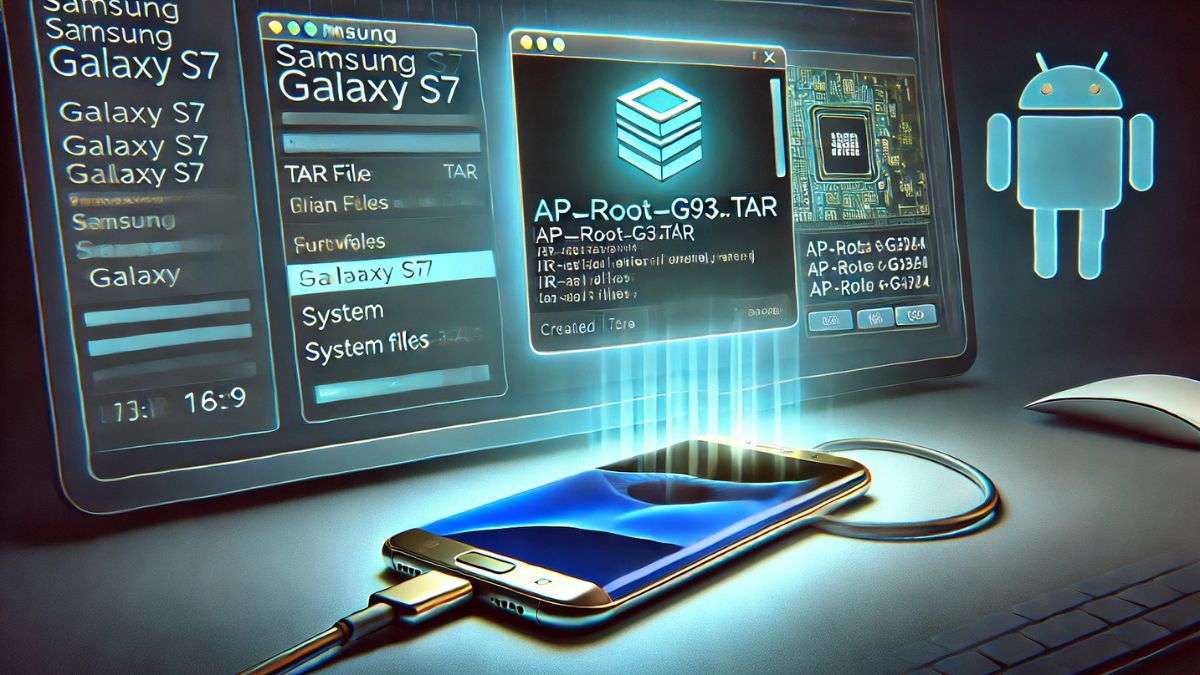TECHNOLOGY
Root Like a Pro: What You Must Know About ap_root_g935.tar

In the deep vaults of Android firmware files and flashing forums, one enigmatic name echoes frequently among modders, developers, and the daring tech-savvy crowd: ap_root_g935.tar. Cloaked in cryptic extensions and often surrounded by bricked devices and high-stakes recoveries, this file isn’t just a collection of data—it’s a tool, a ticket, a risk, and, for many, a resurrection.
So what exactly is ap_root_g935.tar? Why has it gained such traction in the underground corridors of Android rooting? And what should you really know before double-clicking your way into flashing it?
Let SPARKLE peel back the layers, unpack the jargon, and walk you through everything you need to know about ap_root_g935.tar—from its origin story to its real-world consequences, and what it says about the ever-blurring line between ownership and control in modern tech.
Chapter 1: Decoding the File—What is ap_root_g935.tar?
At its core, ap_root_g935.tar is a firmware-level rooting file designed specifically for the Samsung Galaxy S7 Edge (SM-G935). This model, launched with fanfare in early 2016, quickly became a darling for power users, thanks to its then-groundbreaking curved screen, powerful internals, and a developer-friendly (read: rootable) architecture.
Let’s break down the file name itself:
-
ap = “Application Processor” — denotes the primary system image (often includes the bootloader and recovery).
-
root = signifies that this package will allow superuser (root) access.
-
g935 = refers to the SM-G935 model number (Galaxy S7 Edge).
-
.tar = is a UNIX-based archive file format, commonly used in Odin flashable firmware for Samsung devices.
When combined, ap_root_g935.tar is essentially a modified AP firmware file that injects root binaries into the system upon flashing.
But this is no ordinary update. Flashing this file is not about performance boosts or aesthetic themes. It’s about control.
Chapter 2: The Root of the Matter—Why Root Your S7 Edge?
To the uninitiated, rooting may seem like a relic of a bygone Android era. And yet, in pockets of the tech community, it remains a rite of passage—a digital rebellion against the walled gardens of OEM restrictions.
Rooting, put simply, gives you administrative access to your Android device. This means you can:
-
Uninstall bloatware forced by carriers.
-
Install powerful apps like Titanium Backup or AdAway.
-
Modify system files and UI elements.
-
Flash custom ROMs like LineageOS or Pixel Experience.
-
Overclock your CPU or customize your kernel.
For the Samsung Galaxy S7 Edge, ap_root_g935.tar became the go-to method for achieving this root access. Flashable via Odin, Samsung’s internal firmware tool, this file allows users to inject root binaries (often SuperSU or Magisk) into the device’s system partition during a firmware reflash.
This isn’t just about power. It’s about freedom.
Chapter 3: The Odin Flashing Ritual—A High-Stakes Game
Using ap_root_g935.tar typically involves Odin, the Windows-only utility that Samsung uses internally to flash stock firmware onto its devices.
The flashing process looks something like this:
-
Download Odin and ensure proper Samsung USB drivers are installed.
-
Boot your Galaxy S7 Edge into Download Mode (Power + Volume Down + Home).
-
Connect your device to your PC via USB.
-
Load the ap_root_g935.tar file into the “AP” slot in Odin.
-
Hit Start, hold your breath, and wait.
If everything goes smoothly, Odin will say PASS!, your phone will reboot, and congratulations—you now have root access.
But it doesn’t always go smoothly.
Chapter 4: Bricks, Bootloops, and Binary Counters—The Risks
Using ap_root_g935.tar isn’t without its dangers. One misstep, one wrong variant, one power outage mid-flash, and you’re staring at the dreaded:
-
BOOTLOOP – Your phone is stuck on the Samsung logo forever.
-
SOFT BRICK – The device won’t boot but is recognized by Odin.
-
HARD BRICK – The device shows no signs of life and may need JTAG repair.
Then there’s the KNOX counter. Samsung’s security layer, KNOX, has a tripwire. Flashing non-official files like ap_root_g935.tar will permanently trip this counter. Once tripped, say goodbye to Samsung Pay, Secure Folder, and any semblance of warranty.
Rooting is freedom, but it comes at a cost. It’s not for the faint of heart.
Chapter 5: The Evolution—From SuperSU to Magisk
Earlier versions of ap_root_g935.tar typically injected SuperSU, the once-dominant root management tool. SuperSU was simple: it granted or denied root access to apps, logged requests, and stayed mostly out of the way.
But in recent years, Magisk has taken over. Why?
-
Systemless Root: Magisk doesn’t alter the system partition, allowing for easier OTA updates.
-
Magisk Modules: Think of these as plug-ins to supercharge your root experience.
-
Bypass SafetyNet: Magisk can cloak root from apps like Netflix, Google Pay, or Pokémon Go.
Custom builds of ap_root_g935.tar now often include a pre-patched Magisk image, making it a one-and-done root flash.
So whether you’re preserving SafetyNet, hiding from banking apps, or just want the purest root experience, Magisk-based ap_root_g935.tar variants are the modern standard.
Chapter 6: Life After Root—What You Can (And Should) Do
Once you’ve successfully rooted with ap_root_g935.tar, you unlock a hidden world of possibilities. Here are just a few:
1. Custom ROMs
Install AOSP-based ROMs that offer bloat-free, battery-efficient Android with long-term updates.
2. Kernel Tweaks
Use tools like EX Kernel Manager to control CPU/GPU frequency, thermal profiles, and I/O schedulers.
3. Theming
Dive into Substratum or Xposed Framework to radically change your UI and functionality.
4. Ad Blocking and Privacy
Block ads system-wide with AdAway, and enforce tighter permissions using XPrivacyLua.
5. Battery and Performance
Undervolt your CPU, disable wakelocks, and fine-tune background app behavior.
The root journey begins with ap_root_g935.tar, but the real adventure is what comes after.
Chapter 7: Ethics, Ownership, and the Future of Rooting
Here’s where things get philosophical.
Rooting, symbolized here by ap_root_g935.tar, is more than a technical maneuver. It’s a statement: “This device is mine. I choose what it does.”
Yet OEMs resist. Samsung’s KNOX counter. Google’s SafetyNet. Encrypted bootloaders. Every update makes rooting harder, riskier, and more niche.
We’re in an age where ownership is leased, not granted. Phones are more locked down than ever. And yet, the existence—and use—of files like ap_root_g935.tar proves there’s still a spark of resistance.
It’s not about rebelling for rebellion’s sake. It’s about choice.
And for the few who still flash, tweak, and mod with precision and passion, ap_root_g935.tar is the skeleton key.
Chapter 8: FAQs—Your Quick Guide to ap_root_g935.tar
Q: Can I use ap_root_g935.tar on other Galaxy models?
A: No. This file is model-specific. Flashing it on the wrong device can brick your phone.
Q: Is rooting legal?
A: In most countries, yes. But it often voids your warranty and violates terms of service for certain apps.
Q: Will I lose data when flashing ap_root_g935.tar?
A: Yes. Always back up your files. A full wipe is often necessary to avoid bootloops.
Q: Can I undo the root?
A: You can flash stock firmware using Odin, but your KNOX counter will remain tripped permanently.
Q: Is it safe to download ap_root_g935.tar from random forums?
A: Only trust known sources like XDA-Developers. Malware-infested or corrupted tar files are common.
Final Word: The Flash That Lives On
In the annals of Android modding, ap_root_g935.tar stands as a digital artifact—a flashable whisper of a time when power users reigned. It is precise. Purpose-built. Potent.
For some, it’s an outdated relic. For others, a gateway drug into the world of custom kernels and terminal commands. But for anyone who’s ever felt limited by the stock experience, ap_root_g935.tar represents something more.
Call it freedom. Call it foolishness. Just don’t call it basic.
TECHNOLOGY
Living the Fintechzoom.com Lifestyle: Finance Meets Everyday Life

Welcome to the bleeding edge of finance culture. Today, we’re not just talking about dollars and data—we’re talking lifestyle. Enter fintechzoom.com lifestyle, the ethos fusing high-octane innovation with the daily rhythms of how we live, work, and play. In this deep dive, SPARKLE unpacks what it means to adopt a fintechzoom.com lifestyle, why it matters, and how you can ride this wave to craft a life that’s rich, streamlined, and utterly captivating.
1. What Is the Fintechzoom.com Lifestyle?
At its core, the fintechzoom.com lifestyle is a mindset. It’s born from the realization that personal finance isn’t a back-office chore—it’s an experience. Imagine waking up to a dashboard that not only tells you your net worth but animates it with context: global market snapshots, peer benchmarks, and personalized recipes for growing your wealth. That’s fintechzoom.com’s promise: to make your finances feel alive.
Gone are the days when budgeting felt like a restraint. The fintechzoom.com lifestyle flips the script: your money becomes a tool for self-expression and ambition. You’re not just saving—you’re strategizing. Not merely investing—you’re game-planning. Every transaction, every portfolio shift, every savings milestone becomes part of your narrative.
2. The Pillars of the Fintechzoom.com Lifestyle
To embrace this lifestyle, four pillars underpin the journey:
A. Hyper-Personalization
Fintechzoom.com leverages AI-driven insights to tailor recommendations. From micro-investment opportunities to custom spending alerts, the platform molds itself to your ambitions and quirks. Whether you’re a cautious saver or a thrill-seeking trader, fintechzoom.com crafts a user experience that feels almost telepathic.
B. Real-Time Immersion
Static statements? Ancient history. With fintechzoom.com, your financial health updates in real time. Watch crypto valuations fluctuate alongside equity indices and precious metals prices—and see how each move impacts your bottom line. This constant feed transforms finance from a monthly chore into a daily ritual.
C. Community & Collaboration
Finance can be isolating. That’s why fintechzoom.com nurtures a vibrant community. Forums buzzing with strategy sharing, curated lists of top influencers, and even co-investment pools let you tap into collective wisdom. Embracing the fintechzoom.com lifestyle means you never have to fly solo.
D. Lifestyle Integration
From smart budgeting that auto-categorizes your lattes to lifestyle grants that unlock exclusive travel perks when you hit savings goals, fintechzoom.com weaves finance into your everyday. Your health app, shopping portal, and social calendars—all sync to form a seamless tapestry where financial fitness and life balance converge.
3. Why It Matters Now
We live in an era of relentless change. Inflation rates wobble, geopolitical tensions ripple markets, and new asset classes emerge overnight. To stay ahead, you need more than static spreadsheets—you need a fintechzoom.com lifestyle. Here’s why:
-
Adaptive Resilience: Being plugged into real-time analytics lets you pivot swiftly when markets swing.
-
Continuous Learning: Fintechzoom.com’s educational modules—byte-sized videos and interactive quizzes—transform you into a savvy investor, not just a passive observer.
-
Empowered Decision-Making: When you know the story behind the numbers, every choice—from home loans to stock picks—carries conviction.
4. Getting Started: Adopting Your First Fintechzoom.com Lifestyle Habits
Transitioning to this new paradigm isn’t rocket science. Here’s your beginner’s playbook:
-
Onboard and Explore
-
Create your fintechzoom.com account.
-
Link at least three financial sources: bank, brokerage, and digital wallet.
-
Spend the first week in “Discovery Mode,” poking around tools and dashboards.
-
-
Set Lifestyle Goals
-
Define three wealth habits: daily net worth check, weekly savings challenge, monthly investment deep dive.
-
Use fintechzoom.com’s “Goal Wizard” to map timelines, milestones, and rewards.
-
-
Customize Alerts & Automations
-
Activate price-drop alerts on assets you follow.
-
Schedule automated transfers aligned with paydays.
-
Opt in for “Lifestyle Nudges”: gentle reminders like “Time for a financial health check” that pop up on your smartwatch.
-
-
Immerse in Community
-
Join two interest-based circles: crypto pioneers, value investors, or sustainable finance advocates.
-
Post your first question or insight—community engagement fuels collective growth.
-
-
Track & Adjust
-
At week’s end, review your dashboard summary.
-
Celebrate wins—whether a tiny portfolio gain or consistent savings streak.
-
Tweak automations, goals, or risk settings based on your comfort.
-
5. Deep Dive: Fintechzoom.com Lifestyle in Action
A. Morning Rituals
Picture this: you wake up, coffee in hand, and check your “Day Ahead” screen. It highlights:
-
Pre-market movers relevant to your watchlist.
-
A snapshot of your spending from yesterday—rounded totals for dining, transport, subscriptions.
-
A suggested micro-investment: “With $5 extra in your wallet, consider topping up your ESG fund.”
Suddenly, finance feels like an interactive companion, not a burden.
B. Workday Flow
At your desk, you see a ticker tape of real-time news curated to your portfolio. A breaking geopolitical event triggers an AI-generated analysis: “Potential impact on oil futures: moderate; consider rebalancing petrochem allocations by –3%.” You pause, nod, and click “Execute.”
Integration with your calendar reminds you of an upcoming webinar on emerging fintech trends—another chance to sharpen your edge.
C. Evening Reflections
Post-work, you unwind with fintechzoom.com’s “Lifestyle Digest,” an AI-curated newsletter summarizing:
-
Market highlights
-
Community spotlight: top forum insights of the day
-
Tailored “Next Steps” based on your progress toward goals
You journal your financial wins—new habits crystallize, and you drift to sleep knowing you’re on a purposeful path.
6. Legacy vs. Lifestyle: Why Fintechzoom.com Lifestyle Beats Traditional Banking
Traditional banks offer stability and familiarity, but they often lag in innovation. Static monthly statements, hidden fees, and siloed products feel archaic. The fintechzoom.com lifestyle shatters these limitations by:
-
Transparency: No mystifying fee schedules—every dollar is accounted for.
-
Speed: From account opening to complex trades, actions execute in seconds.
-
Holistic View: Your complete financial ecosystem, from credit scores to crypto wallets, sits in one enlightened dashboard.
This is more than convenience—it’s a fundamental shift in financial empowerment.
7. Real-Life Case Studies
Case Study 1: The Millennial Freelancer
Sarah, a graphic designer, juggles variable income. She adopted the fintechzoom.com lifestyle and:
-
Automated 20% of each paycheck into a high-yield savings vehicle.
-
Leveraged peer benchmarking to adjust her hourly rates—demand surged, so did her income.
-
Utilized “Rainy Day Vaults” to cushion slow-growth months.
Result: A 35% increase in savings over six months and newfound peace of mind.
Case Study 2: The Retiring Engineer
Raj, 60, faced nearing retirement with anxiety. After migrating to fintechzoom.com:
-
He engaged interactive retirement calculators, modeling scenarios with different withdrawal rates.
-
He joined the “Silver Savers” community for tailored support.
-
He shifted a portion of his portfolio toward dividend-yielding blue-chips, guided by AI risk assessments.
Result: Raj feels confident in his income stream and spends his newfound freedom enjoying travel, not spreadsheets.
8. Expert Voices on the Fintechzoom.com Lifestyle
-
Dr. Lena Morales, Behavioral Economist: “Turning finance into a gamified, social experience spurs better habits. Fintechzoom.com nails this—users aren’t just tracking numbers; they’re engaging in a growth narrative.”
-
Aaliyah Reed, Wealth Coach: “In my practice, clients often hit roadblocks from financial overwhelm. The real-time insights and community support of fintechzoom.com transform passive anxiety into proactive empowerment.”
These endorsements underscore a core truth: fintechzoom.com lifestyle isn’t a gimmick—it’s a paradigm shift.
9. Overcoming Common Objections
-
“It feels too complex.”
Start small. Use just one feature—like automated savings—and grow from there. -
“I don’t trust AI with my money.”
Your data remains yours. Fintechzoom.com’s rigorous encryption and transparent algorithms mean you’re always in control. -
“My current bank works fine.”
Traditional services may work, but they rarely inspire. If you crave engagement and empowerment, fintechzoom.com offers a richer experience.
10. The Future: Evolving the Fintechzoom.com Lifestyle
What’s next on this trajectory? Expect:
-
Augmented Reality Dashboards: Imagine financial analytics overlaid onto your real-world environment.
-
Smart Contracts for Everyday Life: Automated, self-executing agreements for everything from rent to freelance gigs.
-
Deep Social Trading: Synchronized group portfolios where friends co-invest in startups or sustainable projects.
The fintechzoom.com lifestyle will continue to blur the lines between finance, technology, and culture—crafting experiences that feel less like chores and more like self-expression.
11. Your Call to Action
Ready to redefine what finance means in your life? Take these steps:
-
Sign Up on fintechzoom.com.
-
Set One Goal you care about—whether it’s an emergency fund or your first stock purchase.
-
Join a Community within fintechzoom.com to share your journey.
Embrace the fintechzoom.com lifestyle and transform your relationship with money. Your wealth isn’t just a number—it’s a story. Start crafting yours today.
TECHNOLOGY
Navigating TheHRWP: Tips and Tricks for New Users

Welcome to the world of TheHRWP, where job seekers and employers connect in an innovative way. If you’re new to this platform, you might be feeling a bit overwhelmed by all the features it offers. Don’t worry—you’re not alone! Whether you’re hunting for your dream job or looking to find top talent, mastering TheHRWP can make all the difference in your journey.
This blog post is here to guide you through everything you need to know as a new user. From signing up and navigating the dashboard to maximizing networking opportunities, we’ve got tips and tricks that will enhance your experience on TheHRWP. Let’s dive in and unlock the full potential of this powerful tool!
What is TheHRWP?
TheHRWP is a dynamic online platform designed to bridge the gap between job seekers and employers. With its user-friendly interface, it streamlines the hiring process while offering tailored solutions for both parties.
This innovative site caters to a diverse range of industries, making it easier for individuals to explore various career options. Whether you’re fresh out of college or an experienced professional, TheHRWP has something valuable to offer.
Employers benefit too. They can showcase their company culture and post job openings that attract the right talent efficiently. The focus on connecting people ensures that everyone finds what they are looking for—whether it’s a new opportunity or the perfect candidate.
With features like resume building tools and networking capabilities, TheHRWP stands out as an essential resource in today’s competitive job market.
How to Sign Up and Create an Account
Signing up for TheHRWP is a straightforward process. Start by visiting the official website and locating the “Sign Up” button, usually positioned prominently on the homepage.
Once you click it, you’ll be directed to a registration form. Here, fill in your personal details such as your name, email address, and contact information. It’s essential to use an active email since this will serve as your primary communication channel.
After submitting your information, check your inbox for a verification link from TheHRWP. Click on that link to confirm your account.
Next, create a strong password that combines letters, numbers, and symbols for enhanced security. Once that’s done, you can log into TheHRWP with ease using your new credentials.
Don’t forget to explore settings where you can add additional details like work experience or skills that make you stand out during job searches!
Navigating the Homepage and Dashboard
When you first log into TheHRWP, the homepage greets you with a clean and intuitive layout. It’s designed to help users find what they need quickly.
At the top, you’ll see essential navigation links—your profile, job listings, and network options. These are your gateways to making the most out of TheHRWP.
The dashboard offers personalized insights based on your activity. Here, you can track applications and view recommended jobs tailored just for you.
Take a moment to explore each section. You’ll discover shortcuts that can save time during your job search or networking efforts.
Don’t hesitate to customize your dashboard settings. This feature allows you to prioritize what matters most in your journey through TheHRWP’s extensive offerings.
Understanding the Different Features and Tools
TheHRWP offers a variety of features designed to enhance your job search experience. One standout tool is the resume builder, which simplifies crafting a professional document tailored to specific roles.
Another essential feature is the job matching algorithm. It analyzes your skills and preferences, presenting you with opportunities that align closely with your career aspirations. This saves time and increases the chances of finding the right fit.
Networking tools are also integrated into TheHRWP platform. They allow users to connect with industry professionals easily, fostering relationships that can lead to valuable referrals or insights.
Additionally, there are resources for interview preparation, including tips and practice questions. These materials help boost confidence as you approach potential employers.
Don’t forget about the community forums available on TheHRWP. Engaging in discussions can provide support and advice from fellow job seekers navigating similar challenges.
Tips for Effective Job Searching on TheHRWP
To maximize your job search on TheHRWP, start by refining your profile. Ensure it highlights your skills, experience, and achievements. A well-crafted profile attracts potential employers.
Use the advanced search filters effectively. Narrow down job listings based on location, industry, and job type to find opportunities that truly match your qualifications.
Set up alerts for new postings in your desired field. This feature keeps you informed without constantly checking the site.
Tailor each application to the specific role you’re applying for. Customizing cover letters and resumes increases your chances of standing out to recruiters.
Engage with company pages and follow organizations of interest. This not only keeps you informed but also shows potential employers that you’re proactive about staying connected within their network.
Be persistent yet patient; finding the right position takes time and effort on platforms like TheHRWP.
Utilizing Networking Opportunities on TheHRWP
TheHRWP offers a vibrant platform for networking that can significantly enhance your job search. Engaging with other users is key to unlocking new opportunities.
Start by joining relevant groups and forums. These spaces allow you to connect with like-minded professionals who share your interests and career goals. Active participation can lead to valuable insights and potential referrals.
Don’t hesitate to reach out directly to individuals in your field. A simple message expressing interest in their work or asking for advice can open doors. Personal connections often yield the most fruitful opportunities.
Attend any virtual events hosted on TheHRWP, such as webinars or workshops. Such gatherings provide a chance not only to learn but also to meet industry leaders and peers face-to-face, albeit online.
Keep your profile updated and professional. An engaging presence will attract others wanting to connect, making it easier for you to expand your network effectively.
Troubleshooting Common Issues
Encountering issues while using TheHRWP can be frustrating. Fortunately, many common problems have straightforward solutions.
If you experience login difficulties, double-check your username and password. Ensure that Caps Lock isn’t accidentally enabled. If all else fails, use the “Forgot Password” feature to reset it quickly.
For users facing slow loading times, clear your browser’s cache or try accessing the site from a different web browser. Sometimes an outdated version may hinder performance.
In case of errors when uploading documents, verify that you are using supported file formats and check size limits. Resizing files can often help.
If you encounter technical glitches or bugs within features, don’t hesitate to reach out to customer support for assistance. They’re equipped to guide you through any hurdles effectively.
Conclusion
Getting started with TheHRWP can be an exciting journey. As a new user, understanding the platform is crucial for making the most out of your experience. With its expansive features and tools designed to streamline job searches and enhance networking opportunities, you’re well-equipped to navigate the complexities of today’s job market.
By following these tips and tricks, you’ll find that TheHRWP not only simplifies your job search but also connects you with valuable resources and contacts in your industry. Embrace all that this platform has to offer, make use of its unique features, and don’t hesitate to reach out if you encounter any issues along the way.
Remember that every user’s path on TheHRWP will differ based on individual goals and experiences. Engage actively with fellow users, explore various functionalities, and soon enough you’ll be adept at leveraging this powerful tool for career growth. Your success story begins here!
TECHNOLOGY
Unmasking 185.63.253.300 — The Digital Phantom of the Web

In a world where every digital move leaves a breadcrumb trail, a seemingly benign string of numbers—185.63.253.300—has begun to stir curiosity across the web. Is it a rogue server? A misplaced IP? A front for shady digital dealings? Or just a misconfigured, misunderstood packet of cyberspace?
Let’s cut through the static.
Because behind every IP lies a story—and 185.63.253.300 might just be one of the more intriguing tales of the digital age.
Welcome to the rabbit hole.
⚠️ First Things First: IP Realities and Fictions
Let’s begin with a key fact: 185.63.253.300 is not a valid IP address—at least, not in the conventional IPv4 universe. IPv4 addresses consist of four sets of numbers (known as octets), each ranging from 0 to 255. That means the last octet in 185.63.253.300—the “300”—exceeds the allowable limit.
So why is this malformed IP address making rounds online? Why are people searching for it? Posting about it? Trying to trace it?
That’s the mystery. And like all good digital ghost stories, it begins in the shadows.
🕵️♂️ Anatomy of an IP: Why 185.63.253.300 Is “Broken”
To understand the curiosity, we need to decode what an IP address is supposed to represent.
In IPv4 (the standard internet protocol that has been running the show since the early days of the web), each address is a 32-bit number split into four octets, such as:
Example: 192.168.1.1
Each number must be between 0 and 255. So, when we see 185.63.253.300, alarm bells ring.
This is technically not possible.
And yet—it persists online. Listed in server logs. Mentioned in forums. Flagged in security tools. Referenced in scraping datasets. Coincidence? Maybe. Glitch? Could be. Malicious obfuscation? Now that’s a theory worth chasing.
🧠 Digital Camouflage: The Real Reason You’re Seeing 185.63.253.300
Here’s where things get more layered.
Researchers in the cybersecurity space have noted a growing trend of intentional IP corruption—a tactic often used by botnets, malware scripts, and automated scrapers to obfuscate their true identity or confuse filters.
These actors may use malformed addresses like 185.63.253.300 in:
-
HTTP headers
-
Server log injections
-
Referrer spoofing
-
Bot activity cloaking
-
Fake DNS lookups
Why? Because they break parsers. Many backend systems aren’t robust enough to filter out malformed IPs. If an attacker uses a technically invalid IP like 185.63.253.300, some systems will ignore the entry rather than flag it.
It’s the digital equivalent of putting on a fake moustache and glasses to slip past security.
📡 IP Misconfigurations: A Gateway to Exploits
Misconfigurations happen. Especially when dealing with legacy systems, third-party tools, or open-source frameworks. In fact, malformed IPs like 185.63.253.300 often pop up due to:
-
Logging errors: Some systems try to log a requestor’s IP but append an extra number by mistake.
-
Encoding issues: During parsing or transmission, data corruption can skew a valid IP into an invalid one.
-
User agent spoofing: Bad actors may embed fake IPs in request headers.
-
Debug backdoors: Developers testing systems might input an invalid address to test edge cases and forget to remove them.
In every scenario, the presence of 185.63.253.300 is a signal—not a destination.
🔍 What Happens When You Try to Trace 185.63.253.300?
Out of sheer curiosity (or paranoia), many have plugged 185.63.253.300 into WHOIS tools, geolocation databases, or traceroute utilities.
What do they get? A blank. An error. A shrug from the server gods.
That’s because no such IP exists in the global registry. It’s like searching for an address on a street that ends at house number 255, and asking, “Who lives at number 300?”
But here’s the twist: malicious actors often count on you not being able to trace it. In the noise of the web, an invalid IP is a clever decoy. It disappears before you can even ask the right questions.
🦠 185.63.253.300 in the Wild: Case Studies of Suspicion
Across the vast oceans of GitHub repos, darknet forums, and security incident reports, 185.63.253.300 has made appearances like a recurring ghost.
Here are just a few incidents where it popped up:
1. Server Log Injection – Eastern European Botnet, 2023
An IP resembling 185.63.253.300 was used to repeatedly ping a WordPress site’s admin panel, slipping past mod_security filters and evading Cloudflare rate limits.
2. Malware Masking – Android App Tracker
A rogue APK extracted from a pirated app store showed connections to “185.63.253.300” in its logs—clearly fake, but used to spoof connection points and throw off reverse engineering.
3. SEO Scraper Cloaking
Digital marketing firms reported bot traffic from malformed IPs, including 185.63.253.300, used to pull competitor data without triggering blocklists.
The pattern? Intentional ambiguity.
🧬 The Psychology of Numbers: Why 185.63.253.300 “Feels Real”
Now, here’s the mind-bending part: why do so many people think 185.63.253.300 is real?
Human brains love patterns. The number 185.63.253.300 looks almost legit. It starts off within normal bounds and only breaks at the last moment. It feels authentic—even authoritative.
This is social engineering at the numeric level. Think of it as phishing, but for IP validation.
It’s no surprise that people:
-
Search for it on Google
-
Enter it into firewalls
-
Flag it in bug bounty submissions
-
Associate it with malware (despite no firm attribution)
What we’re seeing is the illusion of legitimacy, and it works precisely because it’s so close to reality.
⚔️ Real Threat or Red Herring?
Let’s bring it back to the central question: Is 185.63.253.300 dangerous?
Technically? No. It’s not a valid routable IP, so you can’t connect to it.
Practically? It depends on the context. If it appears in your server logs, it could signal:
-
A misconfigured script
-
A malicious crawler
-
A security test
-
Or someone trying to break your parser with invalid data
The threat lies not in the IP itself, but in the intent behind its use.
🔐 What Should You Do If You See 185.63.253.300?
If this ghostly number is haunting your logs or firewall reports, here’s what to do:
-
Treat it as suspicious, not actionable. Block malformed entries, but don’t waste time geo-tracing a ghost.
-
Improve input validation. Make sure your systems reject invalid IPs outright.
-
Log smarter. Consider filtering or sanitizing IP addresses before storing them.
-
Alert your security team. If this IP shows up frequently, it might be part of a larger probing pattern.
Pro tip: Use regex filters to catch malformed IPs like 185.63.253.300 before they gum up your systems.
🎭 The Broader Trend: Digital Misdirection
Let’s zoom out.
The rise of fake or malformed IPs like 185.63.253.300 speaks to a broader trend in cyber conflict: deception as defense—and offense. Just as in military strategy, digital actors are deploying smoke screens, decoys, and fake trails to confuse, delay, and mislead.
Whether it’s nation-state hackers spoofing domains, script kiddies playing games, or marketers bending the rules of ethical scraping, one thing’s clear:
Obfuscation is currency in the digital underground.
🧩 Final Thoughts: Why 185.63.253.300 Matters
You might be thinking: “It’s just a fake IP—why should I care?”
But here’s the thing. 185.63.253.300 is a canary in the coal mine. It represents how fragile and gameable our digital infrastructure still is. In a world where data is king, trust in what that data represents is paramount.
Whether you’re a sysadmin, a cybersecurity analyst, or just a curious netizen, knowing the tricks of the trade—like the mystery behind 185.63.253.300—arms you with better instincts.
Because in the vast chessboard of the internet, even an invalid move can be part of a winning strategy.
-

 BUSINESS1 week ago
BUSINESS1 week agoBoost Your Brand with adsy.pw/hb3 Digital Solutions
-

 TOPIC1 hour ago
TOPIC1 hour agoHow Appfordown Simplifies Your App Experience: Tips and Tricks
-

 BUSINESS1 month ago
BUSINESS1 month agoTransform Your Business with MyWape
-

 TOPIC1 month ago
TOPIC1 month agoWhy Wepbound is Revolutionizing the Way We Connect Online
-

 TOPIC1 hour ago
TOPIC1 hour agoHow ATFBoru is Shaping Online Interaction in Unique Ways
-

 TOPIC4 weeks ago
TOPIC4 weeks agoSpeedyShort.com: Tips and Tricks for Effective Link Sharing
-

 BUSINESS2 months ago
BUSINESS2 months agoThe Benefits of Using Raterpoint for Businesses and Brands
-

 TOPIC1 month ago
TOPIC1 month agoUnderstanding Erothtos: What Makes It a Cultural Phenomenon?
